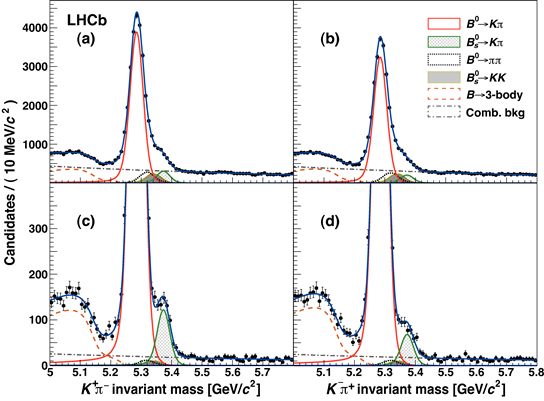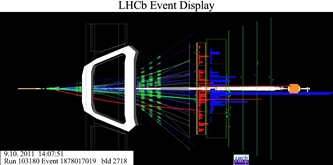[ ACP(B0s→K–π+) = +0.27 ± 0.04 ± 0.01 ]
[ ACP(B0→K+π–) = -0.080 ± 0.007 ± 0.003 ]
The LHCb Collaboration has just submitted for publication a paper which sets an important milestone in the history of particle physics. A difference between properties of matter and antimatter, named CP violation by particle physicists, was discovered in 1964 in the decays of neutral K mesons and was rewarded with the 1980 Nobel Prize in Physics for James Cronin and Val Fitch. M. Kobayashi and T. Maskawa proposed in 1973 a mechanism which could incorporate CP violation within the Standard Model with not less than 6 quarks. In 2001, CP violation was observed in the decay of so-called Beauty Particles, the B0 mesons composed an anti-quark b and a quark d. The Standard model mechanism of CP violation was confirmed and therefore Kobayashi and Maskawa were rewarded with the 2008 Nobel Prize in Physics. In March 2012 the LHCb Collaboration reported an observation of CP violation in charged B± meson decays into DK±. Today, the LHCb Collaboration has announced an observation of CP violation in the decays of Strange Beauty particles, the B0s mesons composed of a beauty antiquark b bound with a strange quark s.
The B0 and B0s meson decays into K and π mesons were studied. The decay into a negative K meson red track and a positive π green track is show in the event displays above.
click the images for higher resolution
The four plots on the left hand side above show the Kπ invariant mass distribution divided into different components as shown by the legend in the top-right figure. The different charge combination of K and π indicates if the decaying B0 or B0s particle is a matter or an antimatter particle. The two upper plots show that the decay rates of B0 mesons are different, as was already well established by previous measurements. The zoom in the lower two plots shows that the difference is also visible around the B0s meson mass, as indicated by the two green Gaussian distributions. Mathematically this difference is described by the asymmetry ACP(B0s→K–π+) = +0.27 ± 0.04 ± 0.01, which differs from zero with significance exceeding five Gaussian standard deviations σ. Therefore this result represents the first observation of CP violation in the decays of B0s mesons. The corresponding asymmetry for B0 meson decays presented in the two upper images, ACP(B0→K+π–) = -0.080 ± 0.007 ± 0.003, is the most precise measurement of this quantity to date.
The full 1.0 fb-1 data sample collected in 2011 was used to obtain these results, the precision will be further improved using the total dataset available which has more than tripled thanks to the excellent 2012 data taking period.
More details can be found in the LHCb paper here. Read also the CERN Press Release in English and French, the CERN Bulletin article in English and French as well as CERN Courier article.



